Strategic Management and Leadership Skills Report - BTEC Unit 1
VerifiedAdded on 2023/06/09
|22
|5673
|66
Report
AI Summary
This report provides a comprehensive analysis of strategic management and leadership skills within the context of Ajman Free Zone (AFZ). It explores the crucial link between strategic management and leadership, examining the impact of various management and leadership styles on strategic decision-making. The report evaluates different leadership styles and their adaptability to diverse situations, using Drotter's pipeline model and other frameworks to illustrate the concepts. Furthermore, it reviews the influence of selected management and leadership theories, such as trait theory, bureaucracy theory, and contingency theory, on organizational strategy. The report also creates a leadership strategy to support the organizational direction of AFZ. The assessment involves reviewing current leadership requirements using appropriate methods and planning for the development of future leadership situations. Finally, the report outlines the development of leadership skills for a specific requirement and reports on the usefulness of the methods used. The analysis incorporates practical examples from AFZ and references a range of academic sources, including Hill et al. (2014), Goetsch and Davis (2014), Ginter et al. (2018), and others.
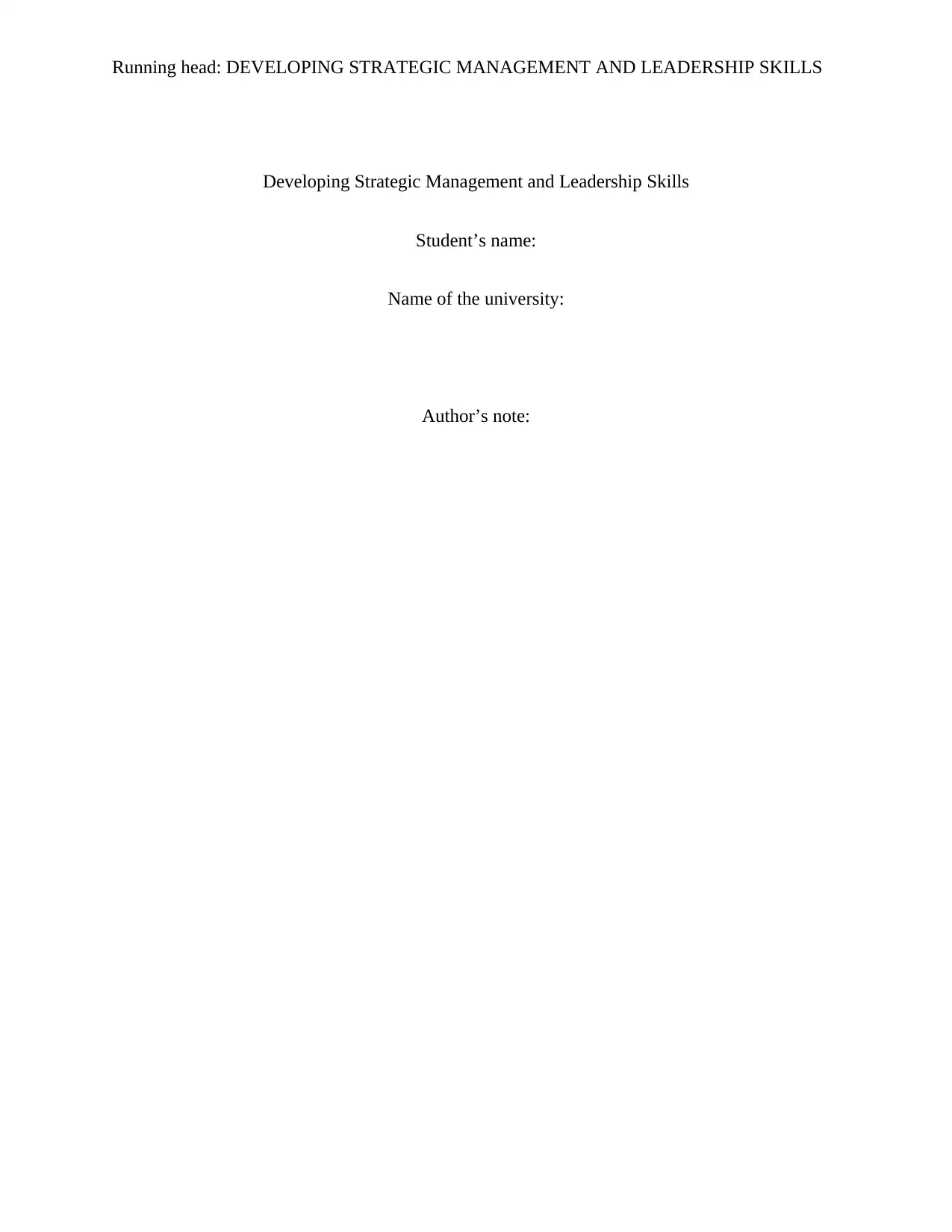
Running head: DEVELOPING STRATEGIC MANAGEMENT AND LEADERSHIP SKILLS
Developing Strategic Management and Leadership Skills
Student’s name:
Name of the university:
Author’s note:
Developing Strategic Management and Leadership Skills
Student’s name:
Name of the university:
Author’s note:
Paraphrase This Document
Need a fresh take? Get an instant paraphrase of this document with our AI Paraphraser
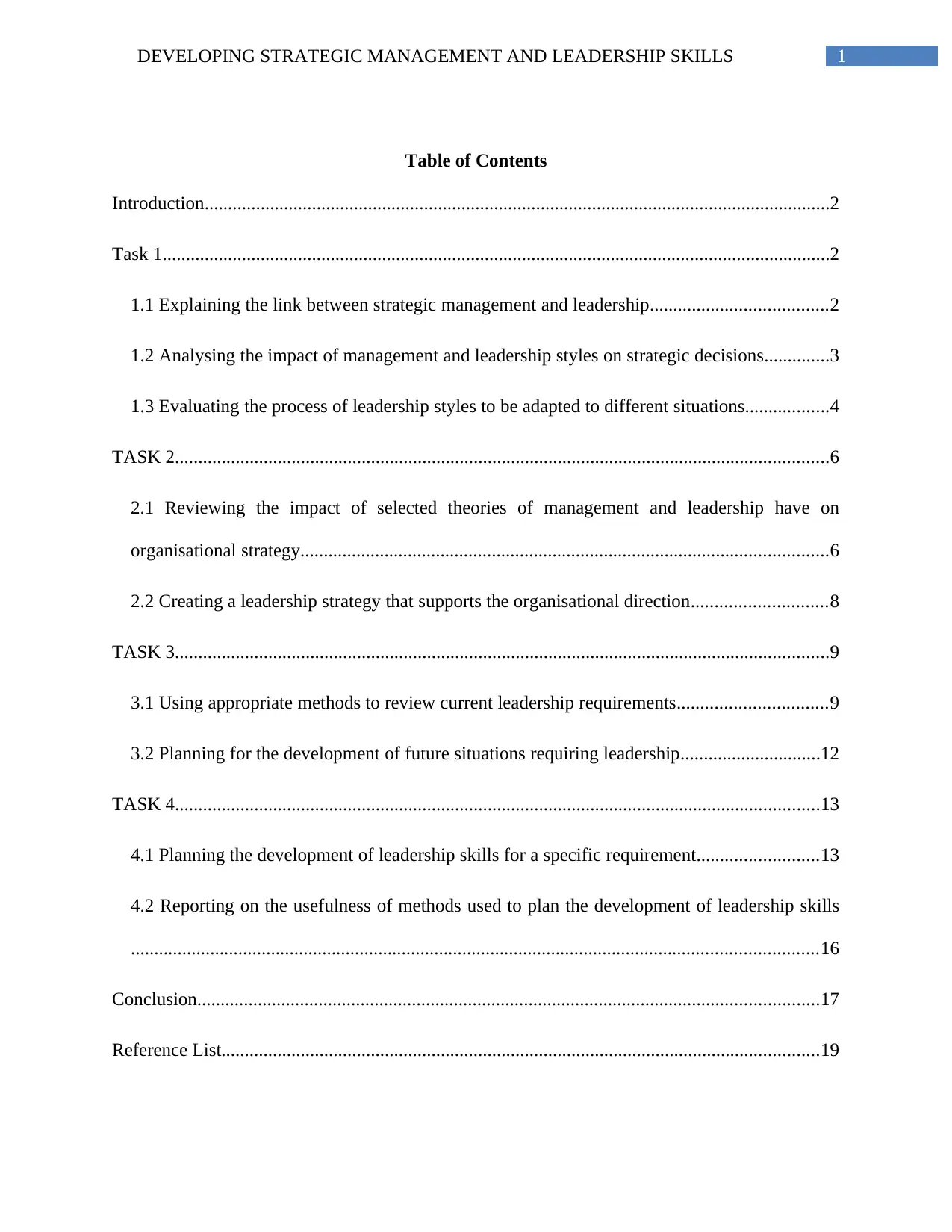
1DEVELOPING STRATEGIC MANAGEMENT AND LEADERSHIP SKILLS
Table of Contents
Introduction......................................................................................................................................2
Task 1...............................................................................................................................................2
1.1 Explaining the link between strategic management and leadership......................................2
1.2 Analysing the impact of management and leadership styles on strategic decisions..............3
1.3 Evaluating the process of leadership styles to be adapted to different situations..................4
TASK 2............................................................................................................................................6
2.1 Reviewing the impact of selected theories of management and leadership have on
organisational strategy.................................................................................................................6
2.2 Creating a leadership strategy that supports the organisational direction.............................8
TASK 3............................................................................................................................................9
3.1 Using appropriate methods to review current leadership requirements................................9
3.2 Planning for the development of future situations requiring leadership..............................12
TASK 4..........................................................................................................................................13
4.1 Planning the development of leadership skills for a specific requirement..........................13
4.2 Reporting on the usefulness of methods used to plan the development of leadership skills
...................................................................................................................................................16
Conclusion.....................................................................................................................................17
Reference List................................................................................................................................19
Table of Contents
Introduction......................................................................................................................................2
Task 1...............................................................................................................................................2
1.1 Explaining the link between strategic management and leadership......................................2
1.2 Analysing the impact of management and leadership styles on strategic decisions..............3
1.3 Evaluating the process of leadership styles to be adapted to different situations..................4
TASK 2............................................................................................................................................6
2.1 Reviewing the impact of selected theories of management and leadership have on
organisational strategy.................................................................................................................6
2.2 Creating a leadership strategy that supports the organisational direction.............................8
TASK 3............................................................................................................................................9
3.1 Using appropriate methods to review current leadership requirements................................9
3.2 Planning for the development of future situations requiring leadership..............................12
TASK 4..........................................................................................................................................13
4.1 Planning the development of leadership skills for a specific requirement..........................13
4.2 Reporting on the usefulness of methods used to plan the development of leadership skills
...................................................................................................................................................16
Conclusion.....................................................................................................................................17
Reference List................................................................................................................................19
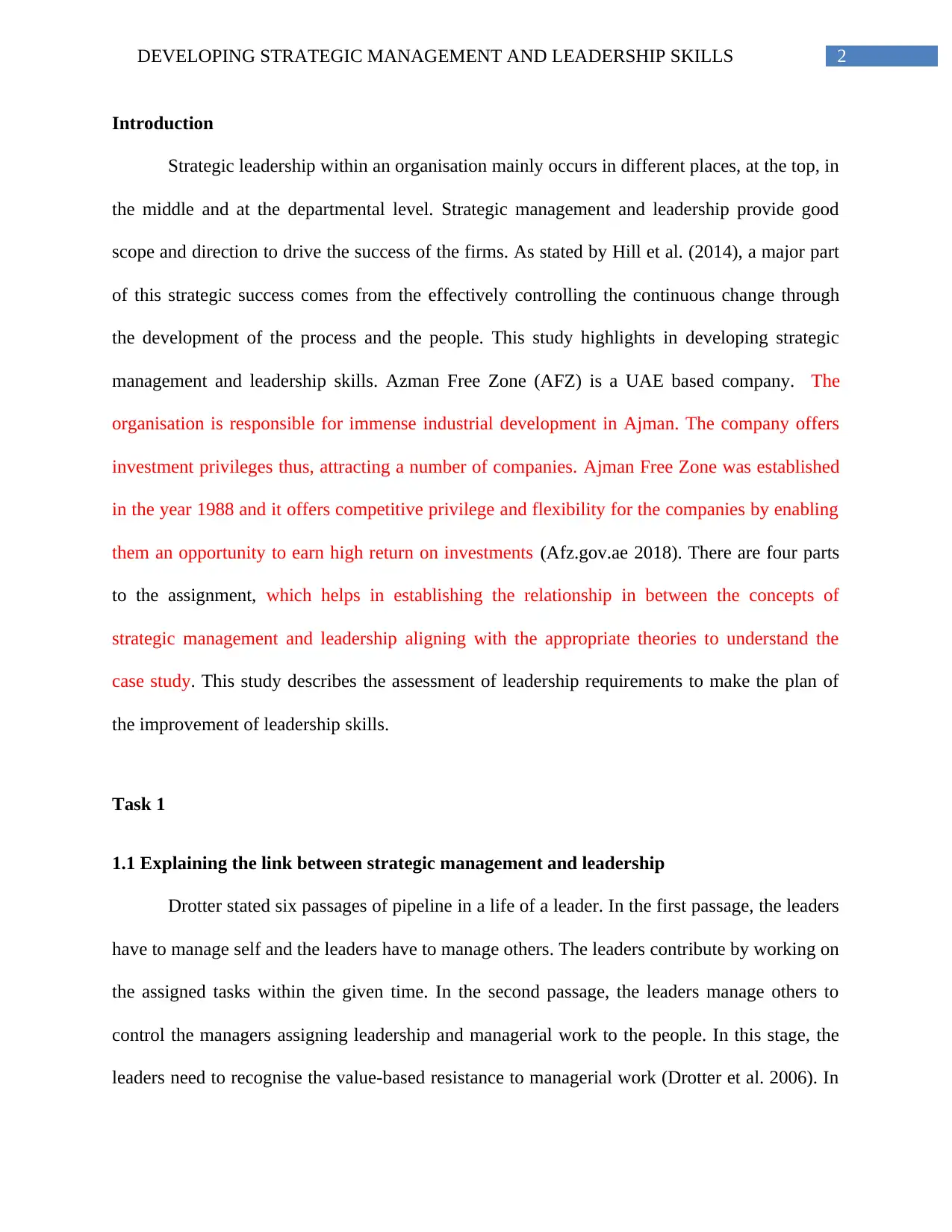
2DEVELOPING STRATEGIC MANAGEMENT AND LEADERSHIP SKILLS
Introduction
Strategic leadership within an organisation mainly occurs in different places, at the top, in
the middle and at the departmental level. Strategic management and leadership provide good
scope and direction to drive the success of the firms. As stated by Hill et al. (2014), a major part
of this strategic success comes from the effectively controlling the continuous change through
the development of the process and the people. This study highlights in developing strategic
management and leadership skills. Azman Free Zone (AFZ) is a UAE based company. The
organisation is responsible for immense industrial development in Ajman. The company offers
investment privileges thus, attracting a number of companies. Ajman Free Zone was established
in the year 1988 and it offers competitive privilege and flexibility for the companies by enabling
them an opportunity to earn high return on investments (Afz.gov.ae 2018). There are four parts
to the assignment, which helps in establishing the relationship in between the concepts of
strategic management and leadership aligning with the appropriate theories to understand the
case study. This study describes the assessment of leadership requirements to make the plan of
the improvement of leadership skills.
Task 1
1.1 Explaining the link between strategic management and leadership
Drotter stated six passages of pipeline in a life of a leader. In the first passage, the leaders
have to manage self and the leaders have to manage others. The leaders contribute by working on
the assigned tasks within the given time. In the second passage, the leaders manage others to
control the managers assigning leadership and managerial work to the people. In this stage, the
leaders need to recognise the value-based resistance to managerial work (Drotter et al. 2006). In
Introduction
Strategic leadership within an organisation mainly occurs in different places, at the top, in
the middle and at the departmental level. Strategic management and leadership provide good
scope and direction to drive the success of the firms. As stated by Hill et al. (2014), a major part
of this strategic success comes from the effectively controlling the continuous change through
the development of the process and the people. This study highlights in developing strategic
management and leadership skills. Azman Free Zone (AFZ) is a UAE based company. The
organisation is responsible for immense industrial development in Ajman. The company offers
investment privileges thus, attracting a number of companies. Ajman Free Zone was established
in the year 1988 and it offers competitive privilege and flexibility for the companies by enabling
them an opportunity to earn high return on investments (Afz.gov.ae 2018). There are four parts
to the assignment, which helps in establishing the relationship in between the concepts of
strategic management and leadership aligning with the appropriate theories to understand the
case study. This study describes the assessment of leadership requirements to make the plan of
the improvement of leadership skills.
Task 1
1.1 Explaining the link between strategic management and leadership
Drotter stated six passages of pipeline in a life of a leader. In the first passage, the leaders
have to manage self and the leaders have to manage others. The leaders contribute by working on
the assigned tasks within the given time. In the second passage, the leaders manage others to
control the managers assigning leadership and managerial work to the people. In this stage, the
leaders need to recognise the value-based resistance to managerial work (Drotter et al. 2006). In
⊘ This is a preview!⊘
Do you want full access?
Subscribe today to unlock all pages.

Trusted by 1+ million students worldwide
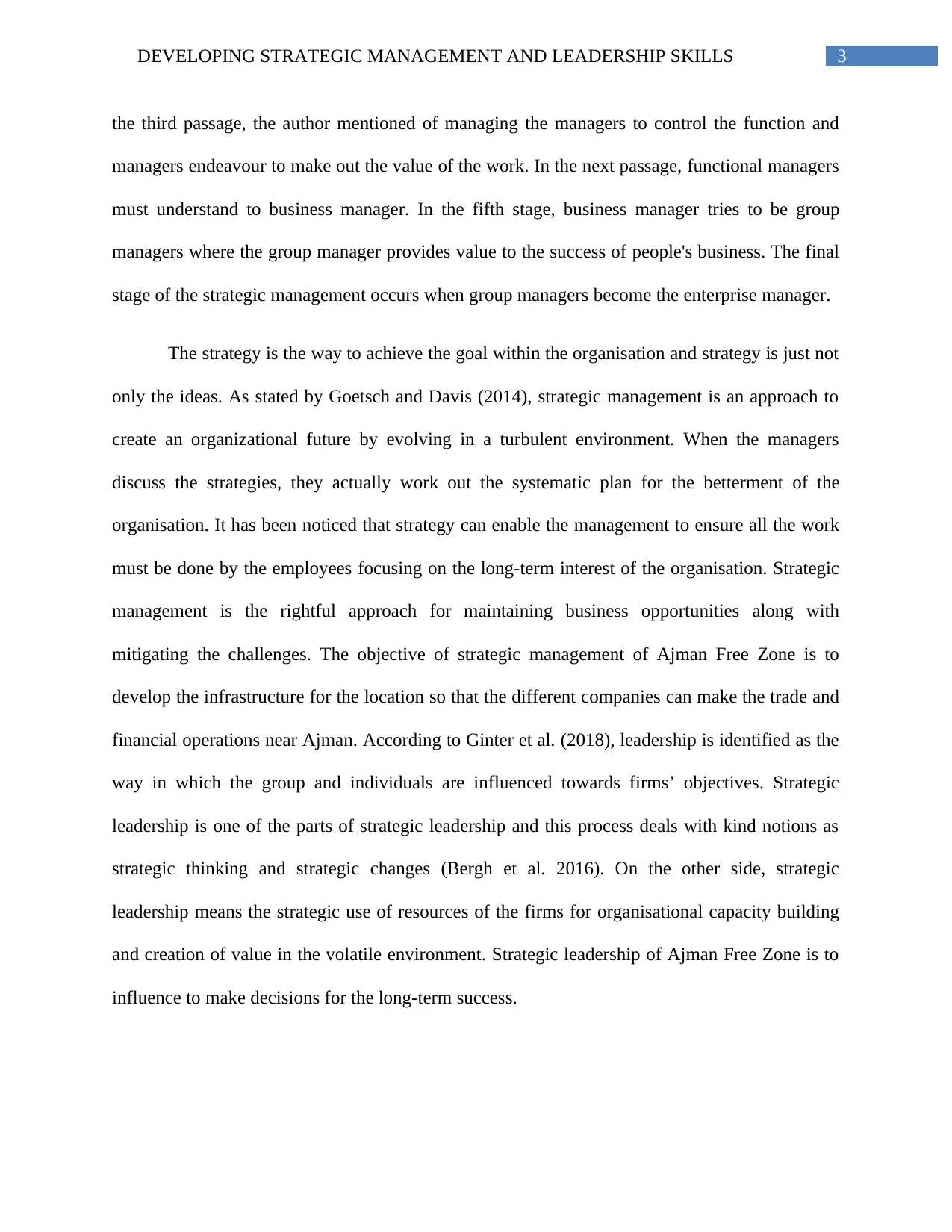
3DEVELOPING STRATEGIC MANAGEMENT AND LEADERSHIP SKILLS
the third passage, the author mentioned of managing the managers to control the function and
managers endeavour to make out the value of the work. In the next passage, functional managers
must understand to business manager. In the fifth stage, business manager tries to be group
managers where the group manager provides value to the success of people's business. The final
stage of the strategic management occurs when group managers become the enterprise manager.
The strategy is the way to achieve the goal within the organisation and strategy is just not
only the ideas. As stated by Goetsch and Davis (2014), strategic management is an approach to
create an organizational future by evolving in a turbulent environment. When the managers
discuss the strategies, they actually work out the systematic plan for the betterment of the
organisation. It has been noticed that strategy can enable the management to ensure all the work
must be done by the employees focusing on the long-term interest of the organisation. Strategic
management is the rightful approach for maintaining business opportunities along with
mitigating the challenges. The objective of strategic management of Ajman Free Zone is to
develop the infrastructure for the location so that the different companies can make the trade and
financial operations near Ajman. According to Ginter et al. (2018), leadership is identified as the
way in which the group and individuals are influenced towards firms’ objectives. Strategic
leadership is one of the parts of strategic leadership and this process deals with kind notions as
strategic thinking and strategic changes (Bergh et al. 2016). On the other side, strategic
leadership means the strategic use of resources of the firms for organisational capacity building
and creation of value in the volatile environment. Strategic leadership of Ajman Free Zone is to
influence to make decisions for the long-term success.
the third passage, the author mentioned of managing the managers to control the function and
managers endeavour to make out the value of the work. In the next passage, functional managers
must understand to business manager. In the fifth stage, business manager tries to be group
managers where the group manager provides value to the success of people's business. The final
stage of the strategic management occurs when group managers become the enterprise manager.
The strategy is the way to achieve the goal within the organisation and strategy is just not
only the ideas. As stated by Goetsch and Davis (2014), strategic management is an approach to
create an organizational future by evolving in a turbulent environment. When the managers
discuss the strategies, they actually work out the systematic plan for the betterment of the
organisation. It has been noticed that strategy can enable the management to ensure all the work
must be done by the employees focusing on the long-term interest of the organisation. Strategic
management is the rightful approach for maintaining business opportunities along with
mitigating the challenges. The objective of strategic management of Ajman Free Zone is to
develop the infrastructure for the location so that the different companies can make the trade and
financial operations near Ajman. According to Ginter et al. (2018), leadership is identified as the
way in which the group and individuals are influenced towards firms’ objectives. Strategic
leadership is one of the parts of strategic leadership and this process deals with kind notions as
strategic thinking and strategic changes (Bergh et al. 2016). On the other side, strategic
leadership means the strategic use of resources of the firms for organisational capacity building
and creation of value in the volatile environment. Strategic leadership of Ajman Free Zone is to
influence to make decisions for the long-term success.
Paraphrase This Document
Need a fresh take? Get an instant paraphrase of this document with our AI Paraphraser
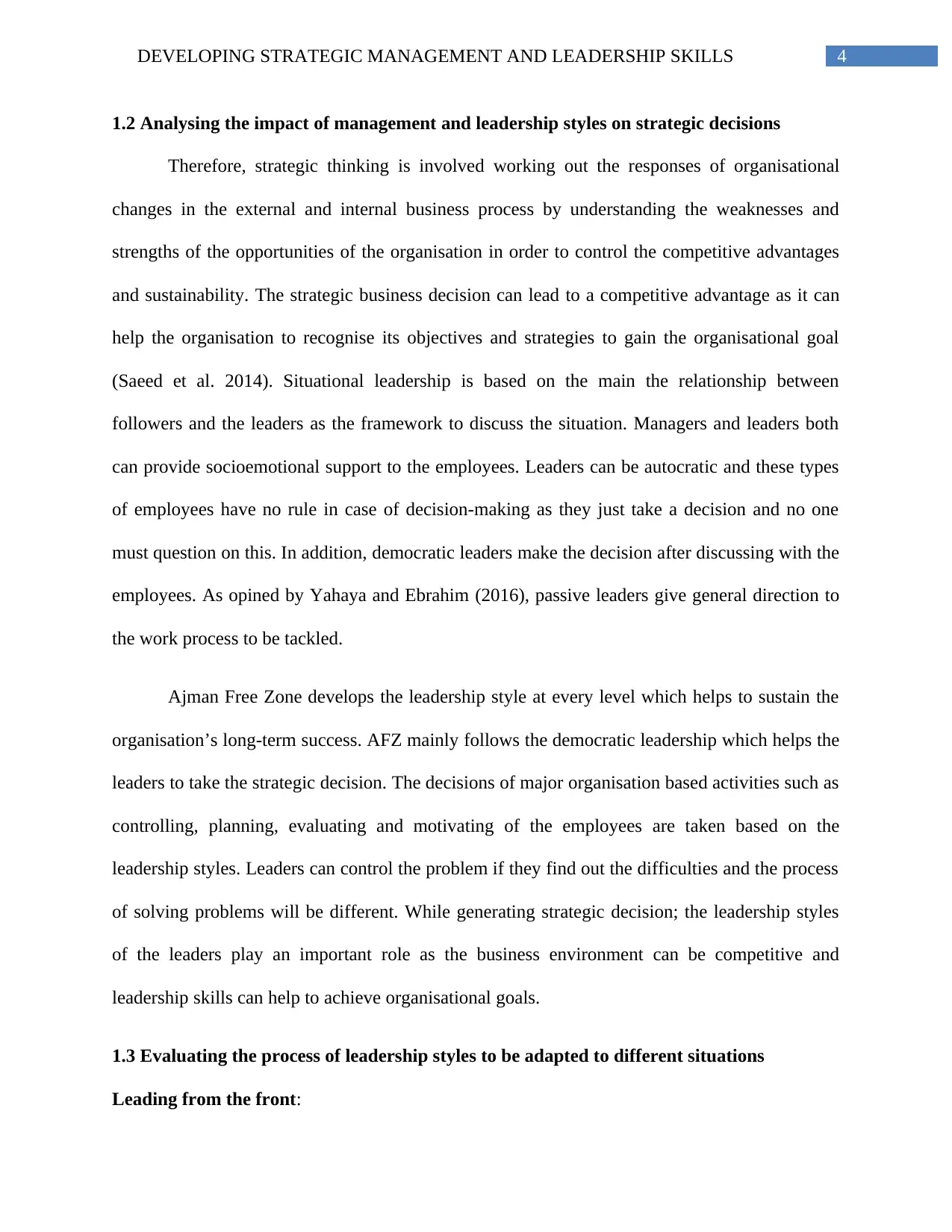
4DEVELOPING STRATEGIC MANAGEMENT AND LEADERSHIP SKILLS
1.2 Analysing the impact of management and leadership styles on strategic decisions
Therefore, strategic thinking is involved working out the responses of organisational
changes in the external and internal business process by understanding the weaknesses and
strengths of the opportunities of the organisation in order to control the competitive advantages
and sustainability. The strategic business decision can lead to a competitive advantage as it can
help the organisation to recognise its objectives and strategies to gain the organisational goal
(Saeed et al. 2014). Situational leadership is based on the main the relationship between
followers and the leaders as the framework to discuss the situation. Managers and leaders both
can provide socioemotional support to the employees. Leaders can be autocratic and these types
of employees have no rule in case of decision-making as they just take a decision and no one
must question on this. In addition, democratic leaders make the decision after discussing with the
employees. As opined by Yahaya and Ebrahim (2016), passive leaders give general direction to
the work process to be tackled.
Ajman Free Zone develops the leadership style at every level which helps to sustain the
organisation’s long-term success. AFZ mainly follows the democratic leadership which helps the
leaders to take the strategic decision. The decisions of major organisation based activities such as
controlling, planning, evaluating and motivating of the employees are taken based on the
leadership styles. Leaders can control the problem if they find out the difficulties and the process
of solving problems will be different. While generating strategic decision; the leadership styles
of the leaders play an important role as the business environment can be competitive and
leadership skills can help to achieve organisational goals.
1.3 Evaluating the process of leadership styles to be adapted to different situations
Leading from the front:
1.2 Analysing the impact of management and leadership styles on strategic decisions
Therefore, strategic thinking is involved working out the responses of organisational
changes in the external and internal business process by understanding the weaknesses and
strengths of the opportunities of the organisation in order to control the competitive advantages
and sustainability. The strategic business decision can lead to a competitive advantage as it can
help the organisation to recognise its objectives and strategies to gain the organisational goal
(Saeed et al. 2014). Situational leadership is based on the main the relationship between
followers and the leaders as the framework to discuss the situation. Managers and leaders both
can provide socioemotional support to the employees. Leaders can be autocratic and these types
of employees have no rule in case of decision-making as they just take a decision and no one
must question on this. In addition, democratic leaders make the decision after discussing with the
employees. As opined by Yahaya and Ebrahim (2016), passive leaders give general direction to
the work process to be tackled.
Ajman Free Zone develops the leadership style at every level which helps to sustain the
organisation’s long-term success. AFZ mainly follows the democratic leadership which helps the
leaders to take the strategic decision. The decisions of major organisation based activities such as
controlling, planning, evaluating and motivating of the employees are taken based on the
leadership styles. Leaders can control the problem if they find out the difficulties and the process
of solving problems will be different. While generating strategic decision; the leadership styles
of the leaders play an important role as the business environment can be competitive and
leadership skills can help to achieve organisational goals.
1.3 Evaluating the process of leadership styles to be adapted to different situations
Leading from the front:
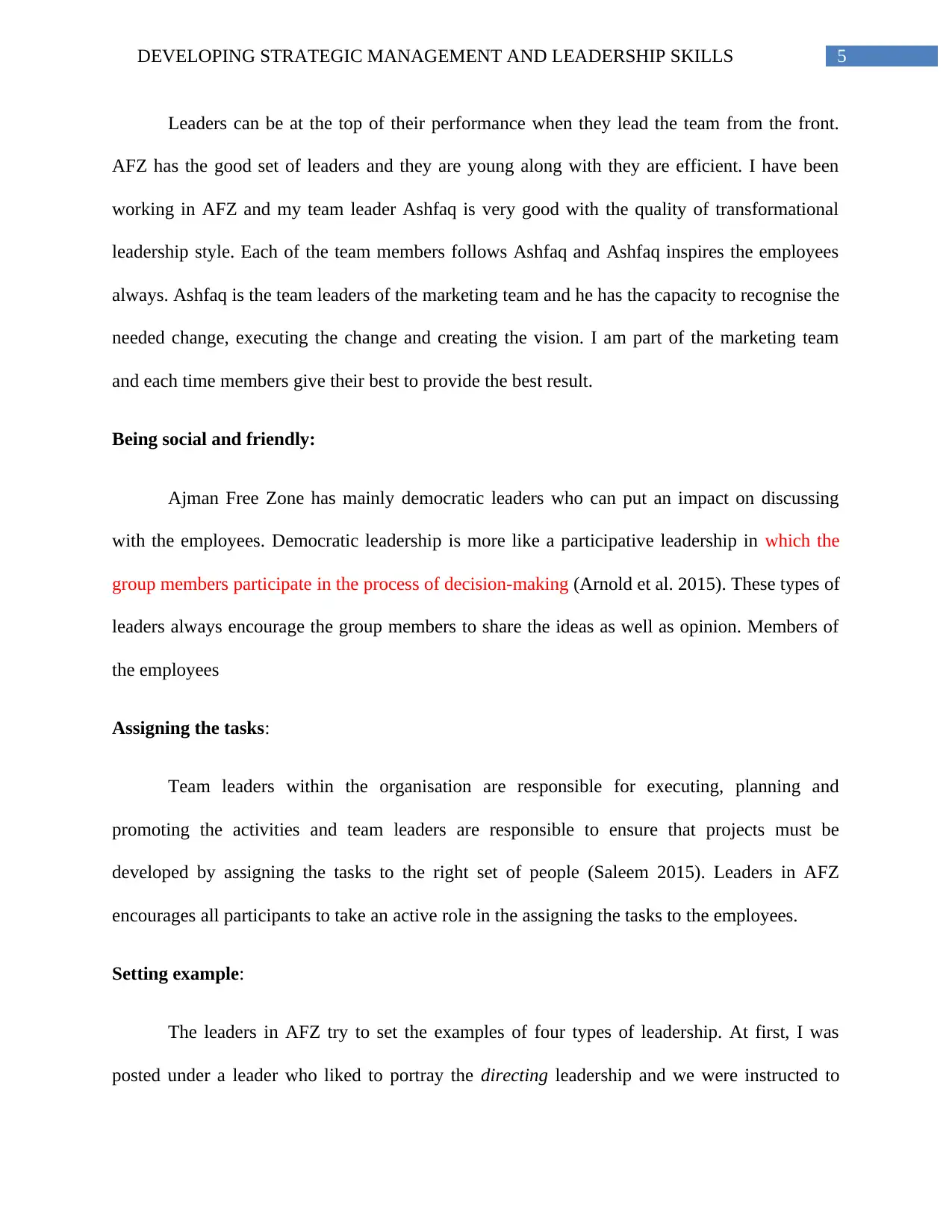
5DEVELOPING STRATEGIC MANAGEMENT AND LEADERSHIP SKILLS
Leaders can be at the top of their performance when they lead the team from the front.
AFZ has the good set of leaders and they are young along with they are efficient. I have been
working in AFZ and my team leader Ashfaq is very good with the quality of transformational
leadership style. Each of the team members follows Ashfaq and Ashfaq inspires the employees
always. Ashfaq is the team leaders of the marketing team and he has the capacity to recognise the
needed change, executing the change and creating the vision. I am part of the marketing team
and each time members give their best to provide the best result.
Being social and friendly:
Ajman Free Zone has mainly democratic leaders who can put an impact on discussing
with the employees. Democratic leadership is more like a participative leadership in which the
group members participate in the process of decision-making (Arnold et al. 2015). These types of
leaders always encourage the group members to share the ideas as well as opinion. Members of
the employees
Assigning the tasks:
Team leaders within the organisation are responsible for executing, planning and
promoting the activities and team leaders are responsible to ensure that projects must be
developed by assigning the tasks to the right set of people (Saleem 2015). Leaders in AFZ
encourages all participants to take an active role in the assigning the tasks to the employees.
Setting example:
The leaders in AFZ try to set the examples of four types of leadership. At first, I was
posted under a leader who liked to portray the directing leadership and we were instructed to
Leaders can be at the top of their performance when they lead the team from the front.
AFZ has the good set of leaders and they are young along with they are efficient. I have been
working in AFZ and my team leader Ashfaq is very good with the quality of transformational
leadership style. Each of the team members follows Ashfaq and Ashfaq inspires the employees
always. Ashfaq is the team leaders of the marketing team and he has the capacity to recognise the
needed change, executing the change and creating the vision. I am part of the marketing team
and each time members give their best to provide the best result.
Being social and friendly:
Ajman Free Zone has mainly democratic leaders who can put an impact on discussing
with the employees. Democratic leadership is more like a participative leadership in which the
group members participate in the process of decision-making (Arnold et al. 2015). These types of
leaders always encourage the group members to share the ideas as well as opinion. Members of
the employees
Assigning the tasks:
Team leaders within the organisation are responsible for executing, planning and
promoting the activities and team leaders are responsible to ensure that projects must be
developed by assigning the tasks to the right set of people (Saleem 2015). Leaders in AFZ
encourages all participants to take an active role in the assigning the tasks to the employees.
Setting example:
The leaders in AFZ try to set the examples of four types of leadership. At first, I was
posted under a leader who liked to portray the directing leadership and we were instructed to
⊘ This is a preview!⊘
Do you want full access?
Subscribe today to unlock all pages.

Trusted by 1+ million students worldwide
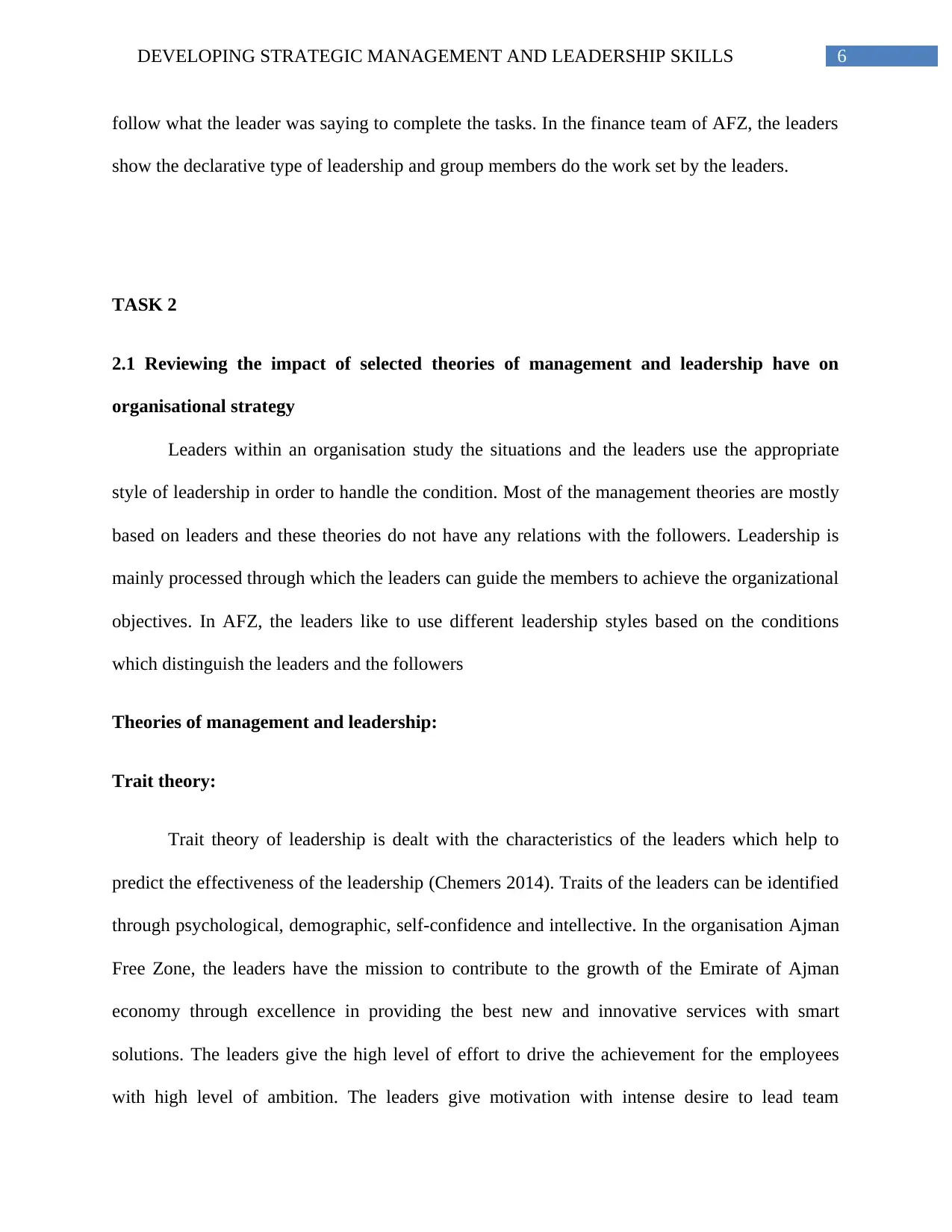
6DEVELOPING STRATEGIC MANAGEMENT AND LEADERSHIP SKILLS
follow what the leader was saying to complete the tasks. In the finance team of AFZ, the leaders
show the declarative type of leadership and group members do the work set by the leaders.
TASK 2
2.1 Reviewing the impact of selected theories of management and leadership have on
organisational strategy
Leaders within an organisation study the situations and the leaders use the appropriate
style of leadership in order to handle the condition. Most of the management theories are mostly
based on leaders and these theories do not have any relations with the followers. Leadership is
mainly processed through which the leaders can guide the members to achieve the organizational
objectives. In AFZ, the leaders like to use different leadership styles based on the conditions
which distinguish the leaders and the followers
Theories of management and leadership:
Trait theory:
Trait theory of leadership is dealt with the characteristics of the leaders which help to
predict the effectiveness of the leadership (Chemers 2014). Traits of the leaders can be identified
through psychological, demographic, self-confidence and intellective. In the organisation Ajman
Free Zone, the leaders have the mission to contribute to the growth of the Emirate of Ajman
economy through excellence in providing the best new and innovative services with smart
solutions. The leaders give the high level of effort to drive the achievement for the employees
with high level of ambition. The leaders give motivation with intense desire to lead team
follow what the leader was saying to complete the tasks. In the finance team of AFZ, the leaders
show the declarative type of leadership and group members do the work set by the leaders.
TASK 2
2.1 Reviewing the impact of selected theories of management and leadership have on
organisational strategy
Leaders within an organisation study the situations and the leaders use the appropriate
style of leadership in order to handle the condition. Most of the management theories are mostly
based on leaders and these theories do not have any relations with the followers. Leadership is
mainly processed through which the leaders can guide the members to achieve the organizational
objectives. In AFZ, the leaders like to use different leadership styles based on the conditions
which distinguish the leaders and the followers
Theories of management and leadership:
Trait theory:
Trait theory of leadership is dealt with the characteristics of the leaders which help to
predict the effectiveness of the leadership (Chemers 2014). Traits of the leaders can be identified
through psychological, demographic, self-confidence and intellective. In the organisation Ajman
Free Zone, the leaders have the mission to contribute to the growth of the Emirate of Ajman
economy through excellence in providing the best new and innovative services with smart
solutions. The leaders give the high level of effort to drive the achievement for the employees
with high level of ambition. The leaders give motivation with intense desire to lead team
Paraphrase This Document
Need a fresh take? Get an instant paraphrase of this document with our AI Paraphraser
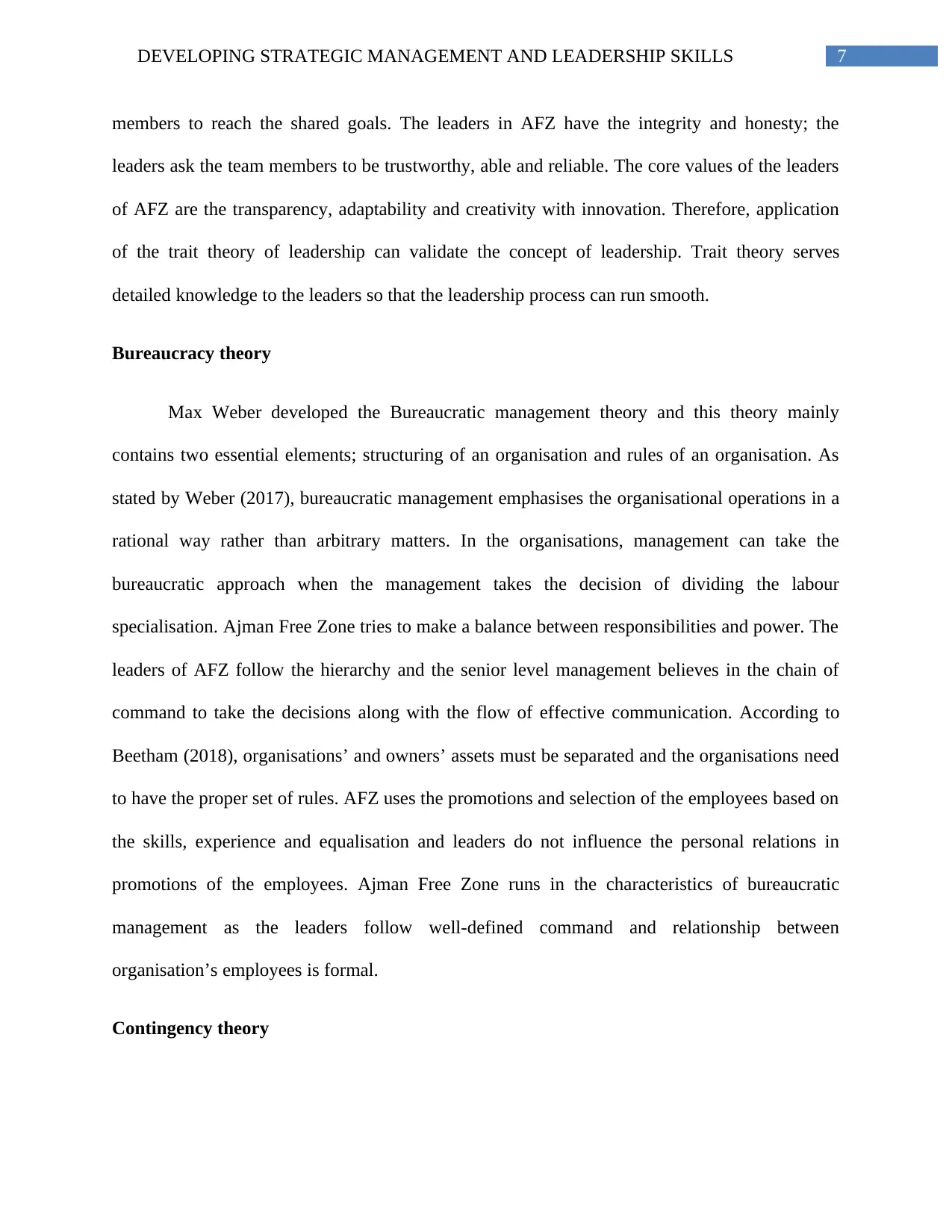
7DEVELOPING STRATEGIC MANAGEMENT AND LEADERSHIP SKILLS
members to reach the shared goals. The leaders in AFZ have the integrity and honesty; the
leaders ask the team members to be trustworthy, able and reliable. The core values of the leaders
of AFZ are the transparency, adaptability and creativity with innovation. Therefore, application
of the trait theory of leadership can validate the concept of leadership. Trait theory serves
detailed knowledge to the leaders so that the leadership process can run smooth.
Bureaucracy theory
Max Weber developed the Bureaucratic management theory and this theory mainly
contains two essential elements; structuring of an organisation and rules of an organisation. As
stated by Weber (2017), bureaucratic management emphasises the organisational operations in a
rational way rather than arbitrary matters. In the organisations, management can take the
bureaucratic approach when the management takes the decision of dividing the labour
specialisation. Ajman Free Zone tries to make a balance between responsibilities and power. The
leaders of AFZ follow the hierarchy and the senior level management believes in the chain of
command to take the decisions along with the flow of effective communication. According to
Beetham (2018), organisations’ and owners’ assets must be separated and the organisations need
to have the proper set of rules. AFZ uses the promotions and selection of the employees based on
the skills, experience and equalisation and leaders do not influence the personal relations in
promotions of the employees. Ajman Free Zone runs in the characteristics of bureaucratic
management as the leaders follow well-defined command and relationship between
organisation’s employees is formal.
Contingency theory
members to reach the shared goals. The leaders in AFZ have the integrity and honesty; the
leaders ask the team members to be trustworthy, able and reliable. The core values of the leaders
of AFZ are the transparency, adaptability and creativity with innovation. Therefore, application
of the trait theory of leadership can validate the concept of leadership. Trait theory serves
detailed knowledge to the leaders so that the leadership process can run smooth.
Bureaucracy theory
Max Weber developed the Bureaucratic management theory and this theory mainly
contains two essential elements; structuring of an organisation and rules of an organisation. As
stated by Weber (2017), bureaucratic management emphasises the organisational operations in a
rational way rather than arbitrary matters. In the organisations, management can take the
bureaucratic approach when the management takes the decision of dividing the labour
specialisation. Ajman Free Zone tries to make a balance between responsibilities and power. The
leaders of AFZ follow the hierarchy and the senior level management believes in the chain of
command to take the decisions along with the flow of effective communication. According to
Beetham (2018), organisations’ and owners’ assets must be separated and the organisations need
to have the proper set of rules. AFZ uses the promotions and selection of the employees based on
the skills, experience and equalisation and leaders do not influence the personal relations in
promotions of the employees. Ajman Free Zone runs in the characteristics of bureaucratic
management as the leaders follow well-defined command and relationship between
organisation’s employees is formal.
Contingency theory
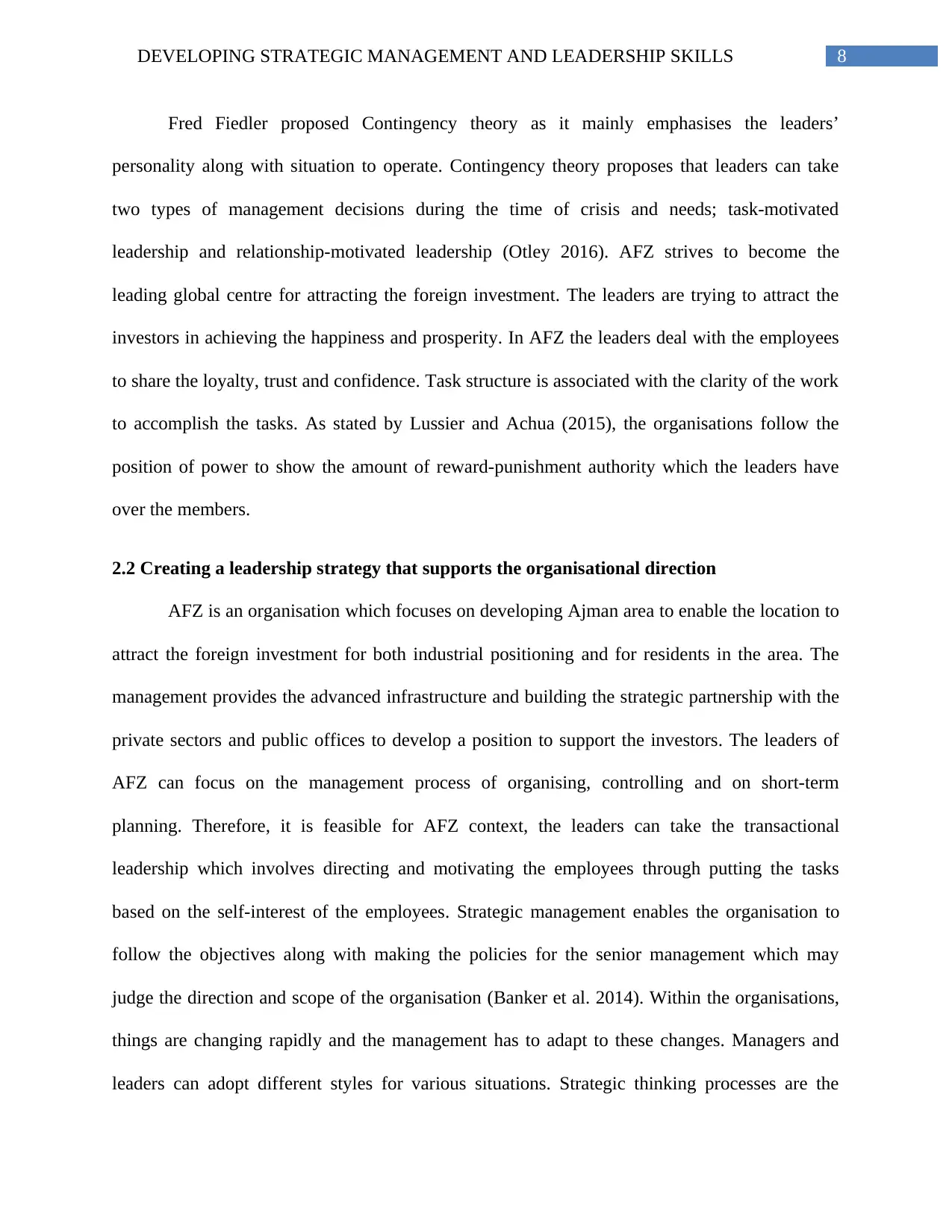
8DEVELOPING STRATEGIC MANAGEMENT AND LEADERSHIP SKILLS
Fred Fiedler proposed Contingency theory as it mainly emphasises the leaders’
personality along with situation to operate. Contingency theory proposes that leaders can take
two types of management decisions during the time of crisis and needs; task-motivated
leadership and relationship-motivated leadership (Otley 2016). AFZ strives to become the
leading global centre for attracting the foreign investment. The leaders are trying to attract the
investors in achieving the happiness and prosperity. In AFZ the leaders deal with the employees
to share the loyalty, trust and confidence. Task structure is associated with the clarity of the work
to accomplish the tasks. As stated by Lussier and Achua (2015), the organisations follow the
position of power to show the amount of reward-punishment authority which the leaders have
over the members.
2.2 Creating a leadership strategy that supports the organisational direction
AFZ is an organisation which focuses on developing Ajman area to enable the location to
attract the foreign investment for both industrial positioning and for residents in the area. The
management provides the advanced infrastructure and building the strategic partnership with the
private sectors and public offices to develop a position to support the investors. The leaders of
AFZ can focus on the management process of organising, controlling and on short-term
planning. Therefore, it is feasible for AFZ context, the leaders can take the transactional
leadership which involves directing and motivating the employees through putting the tasks
based on the self-interest of the employees. Strategic management enables the organisation to
follow the objectives along with making the policies for the senior management which may
judge the direction and scope of the organisation (Banker et al. 2014). Within the organisations,
things are changing rapidly and the management has to adapt to these changes. Managers and
leaders can adopt different styles for various situations. Strategic thinking processes are the
Fred Fiedler proposed Contingency theory as it mainly emphasises the leaders’
personality along with situation to operate. Contingency theory proposes that leaders can take
two types of management decisions during the time of crisis and needs; task-motivated
leadership and relationship-motivated leadership (Otley 2016). AFZ strives to become the
leading global centre for attracting the foreign investment. The leaders are trying to attract the
investors in achieving the happiness and prosperity. In AFZ the leaders deal with the employees
to share the loyalty, trust and confidence. Task structure is associated with the clarity of the work
to accomplish the tasks. As stated by Lussier and Achua (2015), the organisations follow the
position of power to show the amount of reward-punishment authority which the leaders have
over the members.
2.2 Creating a leadership strategy that supports the organisational direction
AFZ is an organisation which focuses on developing Ajman area to enable the location to
attract the foreign investment for both industrial positioning and for residents in the area. The
management provides the advanced infrastructure and building the strategic partnership with the
private sectors and public offices to develop a position to support the investors. The leaders of
AFZ can focus on the management process of organising, controlling and on short-term
planning. Therefore, it is feasible for AFZ context, the leaders can take the transactional
leadership which involves directing and motivating the employees through putting the tasks
based on the self-interest of the employees. Strategic management enables the organisation to
follow the objectives along with making the policies for the senior management which may
judge the direction and scope of the organisation (Banker et al. 2014). Within the organisations,
things are changing rapidly and the management has to adapt to these changes. Managers and
leaders can adopt different styles for various situations. Strategic thinking processes are the
⊘ This is a preview!⊘
Do you want full access?
Subscribe today to unlock all pages.

Trusted by 1+ million students worldwide
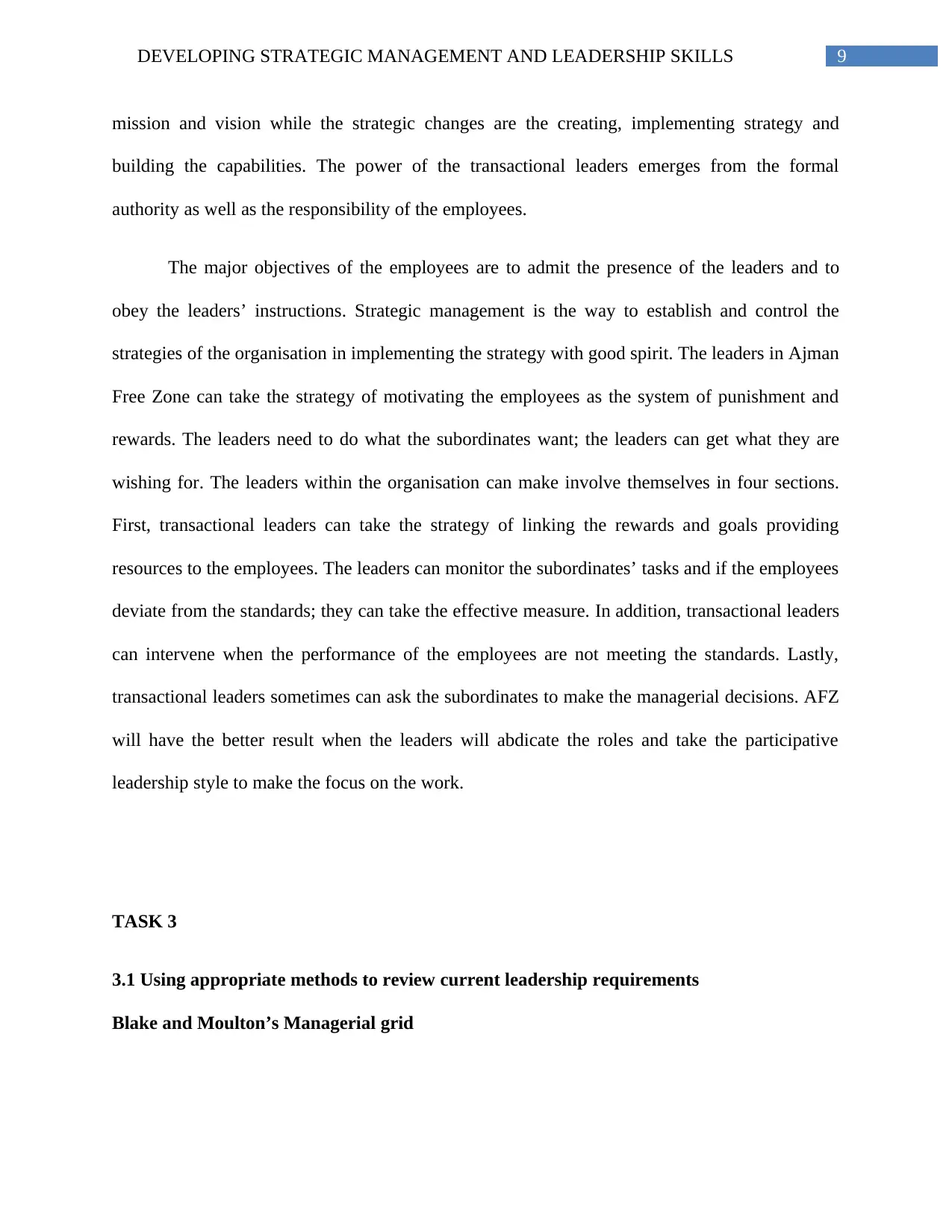
9DEVELOPING STRATEGIC MANAGEMENT AND LEADERSHIP SKILLS
mission and vision while the strategic changes are the creating, implementing strategy and
building the capabilities. The power of the transactional leaders emerges from the formal
authority as well as the responsibility of the employees.
The major objectives of the employees are to admit the presence of the leaders and to
obey the leaders’ instructions. Strategic management is the way to establish and control the
strategies of the organisation in implementing the strategy with good spirit. The leaders in Ajman
Free Zone can take the strategy of motivating the employees as the system of punishment and
rewards. The leaders need to do what the subordinates want; the leaders can get what they are
wishing for. The leaders within the organisation can make involve themselves in four sections.
First, transactional leaders can take the strategy of linking the rewards and goals providing
resources to the employees. The leaders can monitor the subordinates’ tasks and if the employees
deviate from the standards; they can take the effective measure. In addition, transactional leaders
can intervene when the performance of the employees are not meeting the standards. Lastly,
transactional leaders sometimes can ask the subordinates to make the managerial decisions. AFZ
will have the better result when the leaders will abdicate the roles and take the participative
leadership style to make the focus on the work.
TASK 3
3.1 Using appropriate methods to review current leadership requirements
Blake and Moulton’s Managerial grid
mission and vision while the strategic changes are the creating, implementing strategy and
building the capabilities. The power of the transactional leaders emerges from the formal
authority as well as the responsibility of the employees.
The major objectives of the employees are to admit the presence of the leaders and to
obey the leaders’ instructions. Strategic management is the way to establish and control the
strategies of the organisation in implementing the strategy with good spirit. The leaders in Ajman
Free Zone can take the strategy of motivating the employees as the system of punishment and
rewards. The leaders need to do what the subordinates want; the leaders can get what they are
wishing for. The leaders within the organisation can make involve themselves in four sections.
First, transactional leaders can take the strategy of linking the rewards and goals providing
resources to the employees. The leaders can monitor the subordinates’ tasks and if the employees
deviate from the standards; they can take the effective measure. In addition, transactional leaders
can intervene when the performance of the employees are not meeting the standards. Lastly,
transactional leaders sometimes can ask the subordinates to make the managerial decisions. AFZ
will have the better result when the leaders will abdicate the roles and take the participative
leadership style to make the focus on the work.
TASK 3
3.1 Using appropriate methods to review current leadership requirements
Blake and Moulton’s Managerial grid
Paraphrase This Document
Need a fresh take? Get an instant paraphrase of this document with our AI Paraphraser
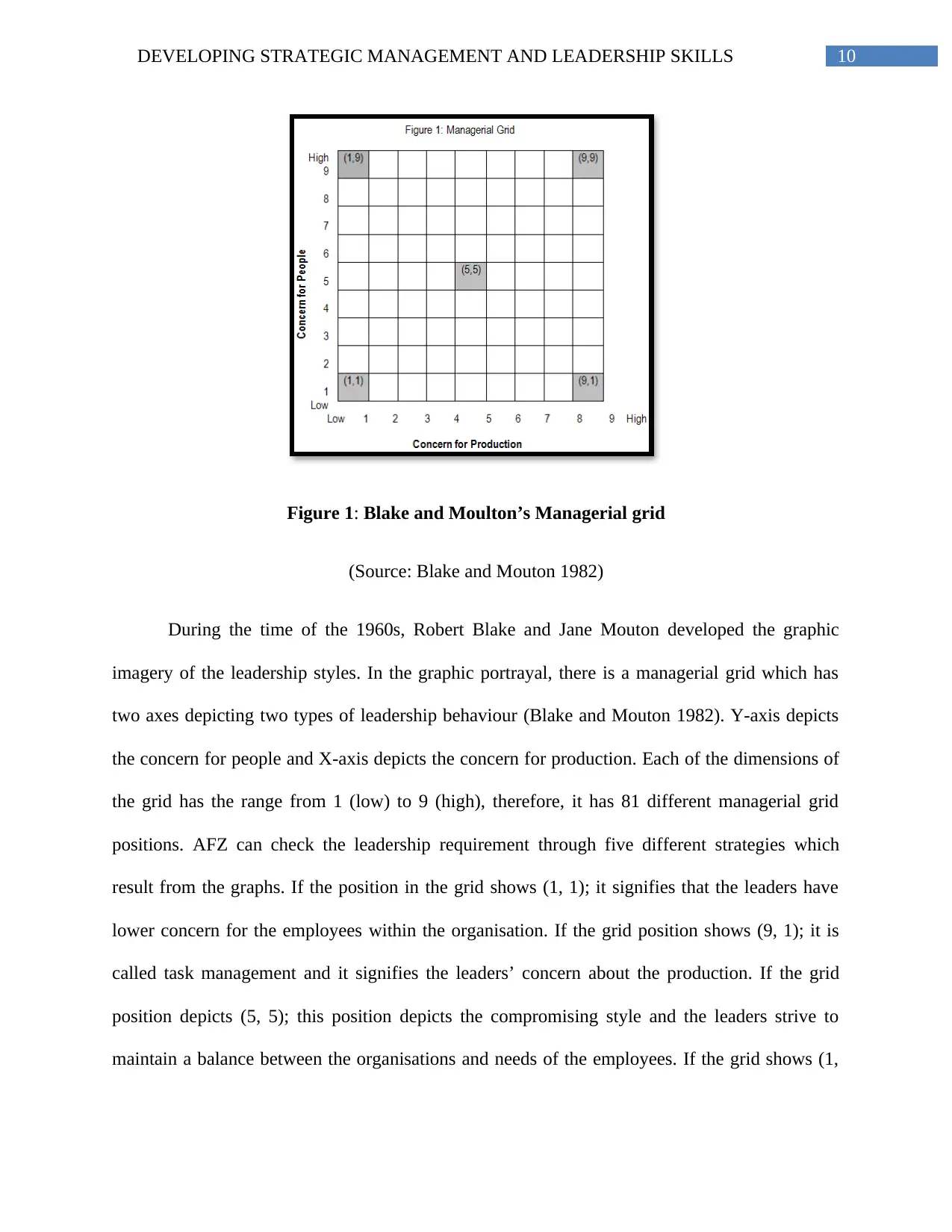
10DEVELOPING STRATEGIC MANAGEMENT AND LEADERSHIP SKILLS
Figure 1: Blake and Moulton’s Managerial grid
(Source: Blake and Mouton 1982)
During the time of the 1960s, Robert Blake and Jane Mouton developed the graphic
imagery of the leadership styles. In the graphic portrayal, there is a managerial grid which has
two axes depicting two types of leadership behaviour (Blake and Mouton 1982). Y-axis depicts
the concern for people and X-axis depicts the concern for production. Each of the dimensions of
the grid has the range from 1 (low) to 9 (high), therefore, it has 81 different managerial grid
positions. AFZ can check the leadership requirement through five different strategies which
result from the graphs. If the position in the grid shows (1, 1); it signifies that the leaders have
lower concern for the employees within the organisation. If the grid position shows (9, 1); it is
called task management and it signifies the leaders’ concern about the production. If the grid
position depicts (5, 5); this position depicts the compromising style and the leaders strive to
maintain a balance between the organisations and needs of the employees. If the grid shows (1,
Figure 1: Blake and Moulton’s Managerial grid
(Source: Blake and Mouton 1982)
During the time of the 1960s, Robert Blake and Jane Mouton developed the graphic
imagery of the leadership styles. In the graphic portrayal, there is a managerial grid which has
two axes depicting two types of leadership behaviour (Blake and Mouton 1982). Y-axis depicts
the concern for people and X-axis depicts the concern for production. Each of the dimensions of
the grid has the range from 1 (low) to 9 (high), therefore, it has 81 different managerial grid
positions. AFZ can check the leadership requirement through five different strategies which
result from the graphs. If the position in the grid shows (1, 1); it signifies that the leaders have
lower concern for the employees within the organisation. If the grid position shows (9, 1); it is
called task management and it signifies the leaders’ concern about the production. If the grid
position depicts (5, 5); this position depicts the compromising style and the leaders strive to
maintain a balance between the organisations and needs of the employees. If the grid shows (1,
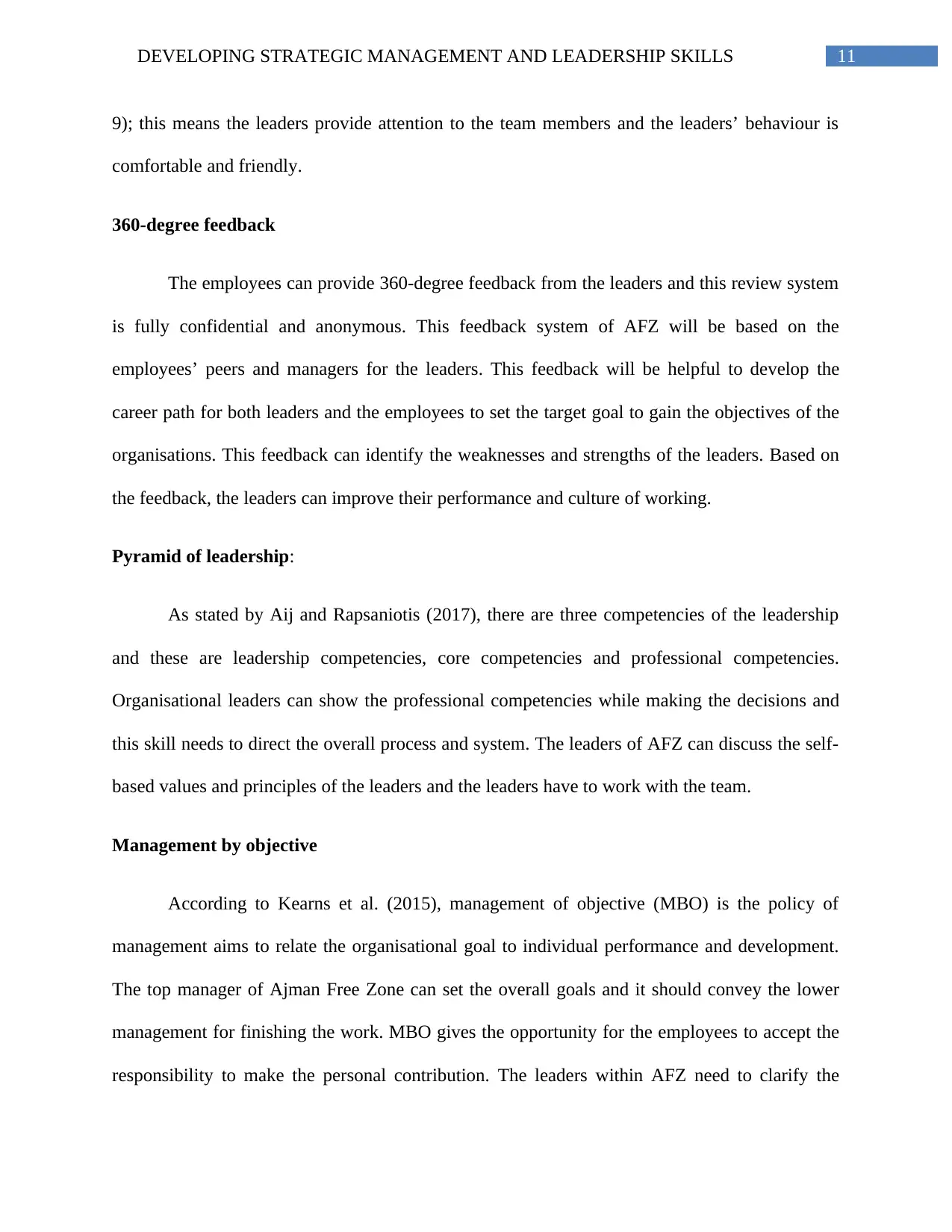
11DEVELOPING STRATEGIC MANAGEMENT AND LEADERSHIP SKILLS
9); this means the leaders provide attention to the team members and the leaders’ behaviour is
comfortable and friendly.
360-degree feedback
The employees can provide 360-degree feedback from the leaders and this review system
is fully confidential and anonymous. This feedback system of AFZ will be based on the
employees’ peers and managers for the leaders. This feedback will be helpful to develop the
career path for both leaders and the employees to set the target goal to gain the objectives of the
organisations. This feedback can identify the weaknesses and strengths of the leaders. Based on
the feedback, the leaders can improve their performance and culture of working.
Pyramid of leadership:
As stated by Aij and Rapsaniotis (2017), there are three competencies of the leadership
and these are leadership competencies, core competencies and professional competencies.
Organisational leaders can show the professional competencies while making the decisions and
this skill needs to direct the overall process and system. The leaders of AFZ can discuss the self-
based values and principles of the leaders and the leaders have to work with the team.
Management by objective
According to Kearns et al. (2015), management of objective (MBO) is the policy of
management aims to relate the organisational goal to individual performance and development.
The top manager of Ajman Free Zone can set the overall goals and it should convey the lower
management for finishing the work. MBO gives the opportunity for the employees to accept the
responsibility to make the personal contribution. The leaders within AFZ need to clarify the
9); this means the leaders provide attention to the team members and the leaders’ behaviour is
comfortable and friendly.
360-degree feedback
The employees can provide 360-degree feedback from the leaders and this review system
is fully confidential and anonymous. This feedback system of AFZ will be based on the
employees’ peers and managers for the leaders. This feedback will be helpful to develop the
career path for both leaders and the employees to set the target goal to gain the objectives of the
organisations. This feedback can identify the weaknesses and strengths of the leaders. Based on
the feedback, the leaders can improve their performance and culture of working.
Pyramid of leadership:
As stated by Aij and Rapsaniotis (2017), there are three competencies of the leadership
and these are leadership competencies, core competencies and professional competencies.
Organisational leaders can show the professional competencies while making the decisions and
this skill needs to direct the overall process and system. The leaders of AFZ can discuss the self-
based values and principles of the leaders and the leaders have to work with the team.
Management by objective
According to Kearns et al. (2015), management of objective (MBO) is the policy of
management aims to relate the organisational goal to individual performance and development.
The top manager of Ajman Free Zone can set the overall goals and it should convey the lower
management for finishing the work. MBO gives the opportunity for the employees to accept the
responsibility to make the personal contribution. The leaders within AFZ need to clarify the
⊘ This is a preview!⊘
Do you want full access?
Subscribe today to unlock all pages.

Trusted by 1+ million students worldwide
1 out of 22
Related Documents
Your All-in-One AI-Powered Toolkit for Academic Success.
+13062052269
info@desklib.com
Available 24*7 on WhatsApp / Email
![[object Object]](/_next/static/media/star-bottom.7253800d.svg)
Unlock your academic potential
Copyright © 2020–2025 A2Z Services. All Rights Reserved. Developed and managed by ZUCOL.




